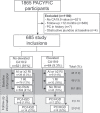The additive value of CA19.9 monitoring in a pancreatic cyst surveillance program
- PMID: 37435855
- PMCID: PMC10493362
- DOI: 10.1002/ueg2.12422
The additive value of CA19.9 monitoring in a pancreatic cyst surveillance program
Abstract
Background: Surveillance of pancreatic cysts focuses on the detection of (mostly morphologic) features warranting surgery. European guidelines consider elevated CA19.9 as a relative indication for surgery. We aimed to evaluate the role of CA19.9 monitoring for early detection and management in a cyst surveillance population.
Methods: The PACYFIC-registry is a prospective collaboration that investigates the yield of pancreatic cyst surveillance performed at the discretion of the treating physician. We included participants for whom at least one serum CA19.9 value was determined by a minimum follow-up of 12 months.
Results: Of 1865 PACYFIC participants, 685 met the inclusion criteria for this study (mean age 67 years, SD 10; 61% female). During a median follow-up of 25 months (IQR 24, 1966 visits), 29 participants developed high-grade dysplasia (HGD) or pancreatic cancer. At baseline, CA19.9 ranged from 1 to 591 kU/L (median 10 kU/L [IQR 14]), and was elevated (≥37 kU/L) in 64 participants (9%). During 191 of 1966 visits (10%), an elevated CA19.9 was detected, and these visits more often led to an intensified follow-up (42%) than those without an elevated CA19.9 (27%; p < 0.001). An elevated CA19.9 was the sole reason for surgery in five participants with benign disease (10%). The baseline CA19.9 value was (as continuous or dichotomous variable at the 37 kU/L threshold) not independently associated with HGD or pancreatic cancer development, whilst a CA19.9 of ≥ 133 kU/L was (HR 3.8, 95% CI 1.1-13, p = 0.03).
Conclusions: In this pancreatic cyst surveillance cohort, CA19.9 monitoring caused substantial harm by shortening surveillance intervals (and performance of unnecessary surgery). The current CA19.9 cutoff was not predictive of HGD and pancreatic cancer, whereas a higher cutoff may decrease false-positive values. The role of CA19.9 monitoring should be critically appraised prior to implementation in surveillance programs and guidelines.
Keywords: CA19.9; GICA; biomarkers; early detection; follow-up; pancreatic cancer; pancreatic cysts; pancreatic lesions; surgical intervention; surveillance.
© 2023 The Authors. United European Gastroenterology Journal published by Wiley Periodicals LLC on behalf of United European Gastroenterology.
Conflict of interest statement
Silvia Carrara: Olympus (lecture). Jeanin E. van Hooft: Boston Scientific (Lecture), Cook medical (Lecture), Abbvie (Lecture), Medtronic (Lecture). Marco J. Bruno: Boston Scientific (Consultant, support for industry and investigator‐initiated studies), Cook Medical (Consultant, support for industry and investigator‐initiated studies), Pentax Medical (Consultant, support for investigator‐initiated studies), Mylan (Support for investigator‐initiated studies), ChiRoStim (Support for investigator‐initiated studies). Other authors declare no conflicts of interest.
Figures





References
-
- Alexakis N, Gomatos IP, Sbarounis S, Toutouzas K, Katsaragakis S, Zografos G, et al. High serum CA 19‐9 but not tumor size should select patients for staging laparoscopy in radiological resectable pancreas head and peri‐ampullary cancer. Eur J Surg Oncol. 2015;41(2):265–269. 10.1016/j.ejso.2014.09.006 - DOI - PubMed
-
- Kim JR, Jang J‐Y, Kang MJ, Park T, Lee SY, Jung W, et al. Clinical implication of serum carcinoembryonic antigen and carbohydrate antigen 19‐9 for the prediction of malignancy in intraductal papillary mucinous neoplasm of pancreas. J Hepato‐Biliary‐Pancreatic Sci. 2015;22(9):699–707. 10.1002/jhbp.275 - DOI - PubMed
MeSH terms
Substances
LinkOut - more resources
Full Text Sources
Medical
Miscellaneous

